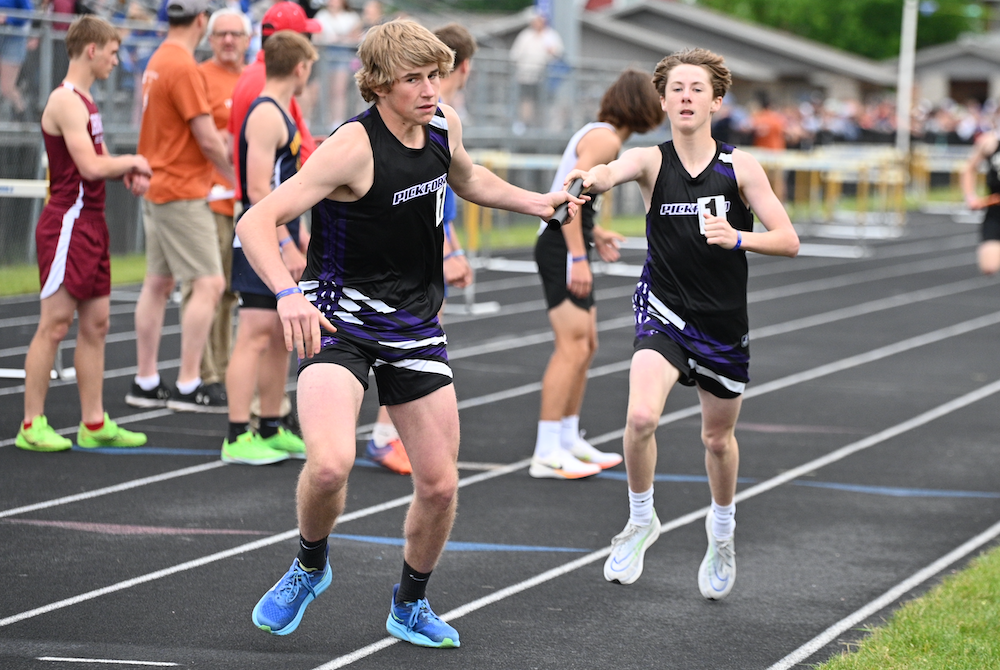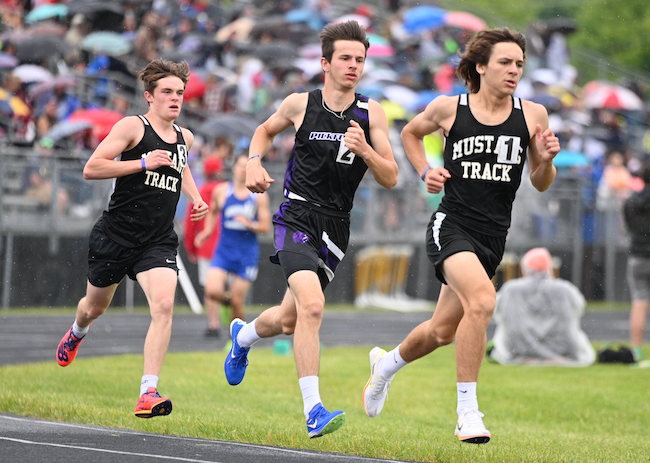
New Math: Division & Multiplication Problems
July 25, 2017
By Jack Roberts
MHSAA Executive Director
This is the second part in a series on MHSAA tournament classification, past and present, that will be published over the next two weeks. This series originally ran in this spring's edition of MHSAA benchmarks.
High school tournament classifications went viral before there was social media and most of us knew what “viral” meant.
Much as a virus infects computers today or has created epidemics of disease around the world for centuries, high school tournament classification – once introduced – tends to spread uncontrollably. Once started, it tends to keep expanding and rarely contracts.
While we are still some distance from providing every team a trophy as a result of expanding high school tournament classification across the country, there is criticism nevertheless that we are headed in that direction – a philosophy which is supposed to exist only in local youth sports for our youngest children.
Michigan could be blamed for all this. Michigan is generally accepted as the first state to provide different classifications for season-ending tournaments for different sized schools. It started a century ago. Today, every state has various classifications for its tournaments in most if not all sports. And it is a bit ironic that Michigan – creator of the classification chaos – more than most other states has kept the number of tournament classes or divisions under control.
Yes, there is evidence that tournament classifications have expanded over the years in Michigan, especially with the relatively recent introduction of tournaments in football and the late 1990s’ move from classes to divisions in most MHSAA tournaments. But the MHSAA Representative Council has held true to its word when it expanded the playoffs for football from four classes to eight divisions: this is needed because of unique factors of football, factors that exist in no other sport; and all other sports should be capped at a maximum of four classes or divisions.
Kentucky is the preeminent defender of single-class basketball. All of its 276 high schools compete for the single state championship for each gender. In Indiana, there are still open wounds from its move in 1998 from one to four classes for its 400 schools in basketball.
Multi-class tournaments have tended to increase the number of non-public school champions, which some states are trying to lower through enrollment “multipliers,” and also tend to increase the number of repeat champions, which some states are trying to affect with “success factors” which lift smaller schools into classifications for larger schools if they take home too many trophies.
While there is considerable evidence that state tournaments do as much bad as good for educational athletics, state associations persist in providing postseason tournaments because, on balance, the experiences are supposed to be good for student-athletes. And once we reach that conclusion it is just a small leap to believe that if the tournaments are good for a few, they must be better for more – which leads to creating more and more tournament classifications. One becomes two classes, then three, then four and so forth.
While the argument is that more classifications or divisions provides more students with opportunities to compete and win, it is undeniable that the experience changes as the number of tournament classifications expands. It is not possible for state associations to provide the same level of support when tournament classifications expand to multiple venues playing simultaneously. For example, there is less audio and video broadcast potential at each venue, and less media coverage to each venue. Focus is diluted and fans diminished at each championship.
No one can argue reasonably that today's two-day MHSAA Football Finals of eight championship games has the same pizazz as the one-day, four-games event conducted prior to 1990.
In some states the number of divisions has grown so much that it is difficult to see much difference between the many season-ending state championship games and a regular-season event in the same sport.
It is a balancing act. And Michigan has been studying that balance longer than any other state, and charting a steadier course than most.
Addition by Division
The shift to Divisions for MHSAA Tournament play in numerous sports has added up to a greater number of champions for teams and individuals across the state. Following are the sports currently employing a divisional format, and the procedures for determining enrollment and classification.
In 23 statewide or Lower Peninsula tournaments, schools which sponsor the sport are currently divided into nearly equal divisions. They are:
- Baseball - 4 Divisions
- Boys Bowling - 4 Divisions
- Girls Bowling - 4 Divisions
- Girls Competitive Cheer - 4 Divisions
- LP Boys Cross Country - 4 Divisions
- LP Girls Cross Country - 4 Divisions
- LP Boys Golf - 4 Divisions
- LP Girls Golf - 4 Divisions
- Ice Hockey - 3 Divisions
- Boys Lacrosse - 2 Divisions
- Girls Lacrosse - 2 Divisions
- Boys Skiing - 2 Divisions
- Girls Skiing - 2 Divisions
- LP Boys Soccer - 4 Divisions LP
- Girls Soccer - 4 Divisions
- Girls Softball - 4 Divisions
- LP Boys Swimming & Diving - 3 Divisions
- LP Girls Swimming & Diving - 3 Divisions
- LP Boys Tennis - 4 Divisions
- LP Girls Tennis - 4 Divisions
- LP Boys Track & Field - 4 Divisions
- LP Girls Track & Field - 4 Divisions
- Wrestling - 4 Divisions
Lists of schools for each division of these 23 tournaments are posted on MHSAA.com approximately April 1. Listings of schools in Upper Peninsula tournaments for their sports are also posted on MHSAA.com. The lists are based on school memberships and sports sponsorships in effect or anticipated for the following school year, as known to the MHSAA office as of a date in early March.
In football, the 256 schools which qualify for MHSAA 11-player playoffs are placed in eight equal divisions annually on Selection Sunday. Beginning in 2017, the 8-player divisions will be determined in a like manner on Selection Sunday as well, with 32 qualifying schools placed in two divisions.
Schools have the option to play in any higher division in one or more sports for a minimum of two years.
The deadlines for "opt-ups" are as follows:
- Applications for fall sports must be submitted by April 15
- Applications for winter sports must be submitted by Aug. 15
- Applications for spring sports must be submitted by Oct. 15
Subsequent to the date of these postings for these tournaments, no school will have its division raised or lowered by schools opening or closing, schools adding or dropping sports, schools exercising the option to play in a higher division, or approval or dissolution of cooperative programs.
When the same sport is conducted for boys and girls in the same season (e.g., track & field and cross country), the gender that has the most sponsoring schools controls the division breaks for both genders.

Pickford Wins Matchup of Reigning Champions to Run Title Streak to 3
By
John Vrancic
Special for MHSAA.com
June 2, 2024
KINGSFORD — The Pickford boys extended their championship reign here Saturday, retaining top honors at the Upper Peninsula Division 2 Track & Field Finals with 137 points.
They were followed by Munising with 106 and Ishpeming with 79. The team championship was the Panthers’ third straight, as they also won Division 3 in 2022.
Sophomore Gunner Bennin was a double-winner for Pickford, taking the 200-meter dash in 23.85 seconds and 400 at 53.36.
“It feels great to come here and win a couple events as a sophomore,” he said. “We knew Iron Mountain had some good sprinters, and Munising is tough. We needed the points. I started faster than I usually do, especially in the 400.
Senior Hayden Hagen provided the Panthers with a first in the 800 (2:05.03), and sophomore John Anderson won high jump at 5 feet, 8 inches.
Panthers junior Tom Storey was runner-up in pole vault (10-6) and high jump (5-7). Hagen was runner-up to Munising junior Dan Goss in the 1,600 (4:39.84) and 3,200 (10:30.81).
Goss ran a personal-best 4:33.98 in the 1,600 and was clocked at 10:23.9 in the 3,200, and anchored the winning 3,200 relay (8:50.22).
 “I like the weather today,” he said. “It was a little humid during the 3,200. Otherwise, it was a good day for running. That was a 10-second PR (personal record) in the 1,600. I’m real happy with that. I’ve been training my tail off the last two weeks.
“I like the weather today,” he said. “It was a little humid during the 3,200. Otherwise, it was a good day for running. That was a 10-second PR (personal record) in the 1,600. I’m real happy with that. I’ve been training my tail off the last two weeks.
“The field events hurt us, but overall I’m happy with how our team did. I had a PR in every event including a split of 2 minutes flat in the 3,200 relay.”
Munising – the Division 3 champion in 2023 – also took the 800 relay (1:36.19), and Pickford was runner-up (1:38.18). The Panthers claimed the 1,600 relay (3:43.36) and placed second in the 3,200 (8:52.74).
Munising senior Joe Kelley added firsts in the 110 hurdles (16.46) and the 300s (42.12) and helped the Mustangs take second in the 400 relay (46.19) and 1,600 (3:48.86). Mustangs’ senior Trevor Nolan added a third in the 1,600 (4:43.41), followed by Bark River-Harris freshman Ben Knauf in a personal-best 4:48.04.
Ishpeming got a first on senior Brayden Martin’s throw of 123-9¼ in discus, and Hancock senior Myles Lewis took shot put (42-11½).
The Hematites got seconds from senior Tramon Gauthier in long jump (18-7¾), 110 hurdles (16.47) and 300s (43.62), and freshman Kemper Gearhart was third in the 3,200 (10:41.5).
Ironwood sophomore Talon Hughes placed second in the 100 (11.51) and 200 (23.98) and third in the 110 hurdles (16.55).
Iron Mountain senior Matt Colavecchi had a hand in three firsts, taking the 100 (11.44), long jump (19-8¼) and anchoring the winning 400 relay (45.92).
Rudyard got a first on junior Jaydon Niemi-Alcorn’s leap of 11-6 in pole vault. Taking runner-up for the Bulldogs were senior teammate Kaeden Sistrunk in shot put (40-8) and junior Ethan Hoolsema in discus (120-0).
PHOTOS (Top) Pickford's Jacob Mitchell hands off the baton to Eli MacDonald for the last leg of the 3,200 relay Saturday at Kingsford. (Middle) During a rainy 1,600, Munising's Dan Goss (1) leads the race with Pickford's Hayden Hagen (2) and Munising's Trevor Nolan (3) right behind him. (Click for more from Cara Kamps/RunMichigan.com.)

